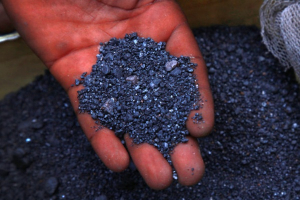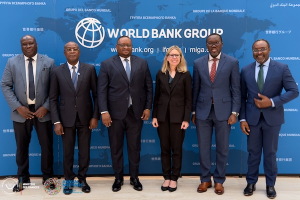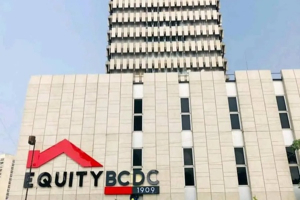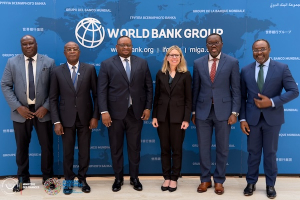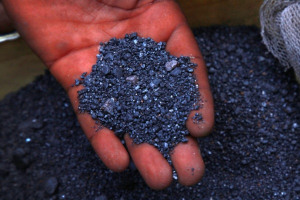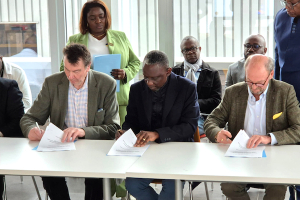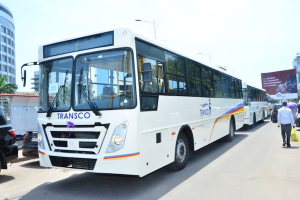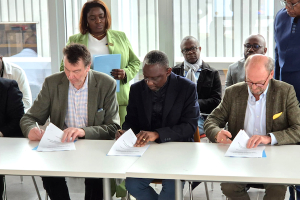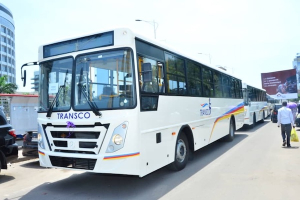Equipe Publication
Coltan: Manono Suspends Illegal $110 Truck Tax Imposed by Security Agents
-
Manono’s territorial administrator Cyprien Kitanga suspended an illegal tax of at least $110 per mining truck imposed by security agents from ANR and DEMIAP.
-
The tax, known as “assistance,” had been collected from coltan and cassiterite transporters without legal basis.
-
Kitanga warned that any official defying the suspension would face disciplinary sanctions for insubordination.
Manono’s territorial administrator, Cyprien Kitanga, on October 17, 2025, suspended an illegal tax that security officers had been collecting from mining transporters in the Tanganyika province of the Democratic Republic of Congo.
The decision followed a meeting between Kitanga and regional mining operators. Security agents from the National Intelligence Agency (ANR) and the Military Detection of Anti-Patriotic Activities (DEMIAP) had been charging truck drivers at least $110 per vehicle, under a levy locally called “assistance.”
Under the scheme, ANR officers collected $100 per truck, while DEMIAP agents imposed an additional fee ranging between $10 and $50. Kitanga said the charges lacked any legal basis and directly discouraged mining investment in the territory.
“These collections have no foundation in law and represent an obstacle to the region’s economic recovery,” Kitanga stated. He ordered all agencies involved to comply immediately with the suspension and warned that any defiant official would face sanctions for insubordination.
Manono, located in Tanganyika province, is regaining economic momentum amid renewed mining activity. The area hosts one of the world’s largest untapped lithium deposits, a critical mineral for the global electric vehicle battery industry.
Besides lithium, Manono’s subsoil contains cassiterite (tin ore), coltan, wolframite, and tourmaline—minerals that make the region strategically important for the DRC’s mining sector and for international supply chains seeking alternatives to Chinese and South American sources.
This article was initially published in French by Ronsard Luabeya
Adapted in English by Ange Jason Quenum
DR Congo Seeks $500mln World Bank Loan for Lobito Corridor Project
During the IMF and World Bank Annual Meetings, the Democratic Republic of Congo’s Finance Minister, Doudou Fwamba, presented a $500 million financing request to the World Bank to support the Lobito Corridor project. According to a statement from the Finance Ministry, the institution has agreed to review the proposal.
In talks with World Bank Managing Director for Operations Anna Bjerde, the minister outlined the government’s vision to spur economic growth along the strategic transport corridor. The discussions focused on strengthening cooperation for the development of two main segments: Tenke–Lubumbashi–Sakania and Tenke–Kolwezi–Dilolo, extending to the Angolan border and the port of Lobito.
Feasibility studies presented in September by a joint European Union–U.S. expert team estimated rehabilitation costs for the Tenke–Kolwezi–Dilolo line at $400–410 million, with $180 million in maintenance costs over ten years. The second phase, covering the Tenke–Lubumbashi–Sakania section and its extension to the Zambian border, would bring total investment to around $1.1 billion.
Fwamba stressed that the project’s economic success depends on expanding energy and mining production and increasing local processing capacity—factors expected to create jobs and stimulate agricultural growth.
Anna Bjerde welcomed Congo’s ongoing economic reforms and highlighted the Lobito Corridor’s strategic value as a regional driver for logistics, energy, and agro-industry.
The Congolese government has pledged to promote cross-border projects similar to those underway in Angola, Zambia, and Tanzania. In April 2025, Prime Minister Judith Suminwa directed the preparation of development projects along the corridor, under the supervision of the Ministers of Transport and Planning and the Mattei Committee experts.
Last September, the World Bank also launched a feasibility study on the corridor’s economic impact, conducted jointly by researchers from the Universities of Lubumbashi and Kolwezi and the Bank’s teams. The study aims to identify investment opportunities along the Congolese section to maximize its economic and social benefits.
Congo’s Central Bank Pressures Banks to Curb Dollar Use and Support the Franc
The Central Bank of Congo (BCC) has criticized several commercial banks for practices that undermine the use of the national currency. In a statement issued on October 17, 2025, the BCC accused some institutions of “creating long queues at counters under the pretext of liquidity shortages and forcing customers to conduct transactions in foreign currencies, even when they legitimately wish to use the Congolese franc (FC).”
These practices contradict the goals of BCC Governor André Wameso, appointed in July 2025, who has made restoring trust in the franc congolais and reducing dollar dependence his top priorities.
In response, the BCC sent two letters to commercial banks instructing them to immediately replenish cash reserves at the central bank to maintain normal service levels. Banks are also required to keep their branches open until 5 p.m., including weekends for high-traffic locations. The central bank reminded them of their legal obligation to promote the use of the national currency and announced upcoming inspections to verify compliance with liquidity and foreign exchange regulations.
EquityBCDC, the country’s second-largest bank after Rawbank, has already announced it will comply with the BCC’s directives. The bank published a list of branches—Masina Sans Fil, Limete Place C, Matonge, Kintambo, Ngaba, Aviateurs, and its headquarters—that will operate daily from 8 a.m. to 5 p.m. throughout the implementation period of the central bank’s measures.
Corridor de Lobito : Kinshasa sollicite 500 millions $ auprès de la Banque mondiale
En marge des Assemblées annuelles du Fonds monétaire international (FMI) et de la Banque mondiale, le ministre congolais des Finances, Doudou Fwamba, a présenté le 18 octobre 2025 à la Banque mondiale une requête de financement de 500 millions de dollars pour appuyer la mise en œuvre du projet du corridor de Lobito. Selon une note du ministère des Finances, l’institution financière a accepté d’examiner cette demande.
Lors d’un entretien avec la directrice générale des opérations de la Banque mondiale, Anna Bjerde, le ministre a exposé la vision du gouvernement, qui vise à stimuler la croissance économique autour de ce corridor stratégique. Les discussions ont permis de consolider les bases d’une coopération élargie, notamment pour le développement des deux tronçons principaux : Tenke–Lubumbashi–Sakania et Tenke–Kolwezi–Dilolo, jusqu’à la frontière angolaise et au port de Lobito.
Selon les conclusions des études de faisabilité présentées en septembre par une délégation conjointe d’experts de l’Union européenne et des États-Unis, la réhabilitation du tronçon Tenke–Kolwezi–Dilolo nécessiterait entre 400 et 410 millions de dollars, avec des coûts d’entretien estimés à 180 millions sur dix ans. La seconde phase du projet, portant sur la section Tenke–Lubumbashi–Sakania et son extension vers la frontière zambienne, porterait l’investissement total à environ 1,1 milliard de dollars.
Doudou Fwamba a insisté sur le fait que la viabilité économique du projet dépendra de la croissance de la production énergétique et minière, ainsi que du renforcement de la transformation locale des matières premières. Ces dynamiques devraient, selon lui, favoriser la création d’emplois et stimuler le développement agricole.
De son côté, Anna Bjerde a salué les réformes économiques engagées par le gouvernement congolais et rappelé l’importance stratégique du corridor de Lobito, considéré comme un levier régional pour la logistique, l’énergie et l’agro-industrie.
Le gouvernement congolais a déjà affiché sa volonté de promouvoir des projets intégrateurs, à l’instar de ceux développés en Angola, en Zambie et en Tanzanie. Lors du Conseil des ministres du 4 avril 2025, la Première ministre Judith Suminwa avait instruit l’élaboration de projets de développement le long du corridor, sous la supervision des ministres des Transports et du Plan, en collaboration avec d’autres membres du gouvernement et les experts du comité Mattei.
En septembre dernier, la Banque mondiale avait par ailleurs annoncé le lancement d’une étude de faisabilité sur l’impact économique du corridor. Réalisée conjointement par des chercheurs des universités de Lubumbashi et de Kolwezi et par les équipes de la Banque mondiale, cette étude vise à identifier les opportunités d’investissement sur la portion congolaise du projet afin d’en maximiser les retombées économiques et sociales.
Ronsard Luabeya
Lire aussi :
Corridor de Lobito : plus 400 millions $ pour réhabiliter la ligne Dilolo–Kolwezi–Tenke
Albert Zeufack appelle à faire de l’emploi une priorité nationale en RDC
Lobito, Kivu–Kinshasa, Kisangani : un financement de 180 millions € de l’UE annoncé
Dédollarisation : la Banque centrale du Congo accentue la pression sur les banques
Dans un communiqué publié le 17 octobre 2025, la Banque centrale du Congo (BCC) a dénoncé les pratiques de certaines banques commerciales qui « entretiennent de longues files d’attente aux guichets, sous prétexte d’un manque de liquidités, et imposent à leurs clients l’exécution des transactions en monnaies étrangères, alors même que ces derniers souhaitent légitimement les réaliser en franc congolais (FC) ».
Cette attitude va à l’encontre des ambitions du nouveau gouverneur de la BCC, André Wameso, nommé en juillet dernier. L’ancien conseiller économique du président Félix Tshisekedi a fait de la restauration de la confiance dans le franc congolais et de la réduction de la dépendance au dollar américain ses priorités.
Face à la situation, la BCC a adressé deux courriers aux banques commerciales. Elle leur demande de s’approvisionner sans délai auprès d’elle pour garantir un service régulier à la clientèle. Les banques doivent également maintenir leurs guichets ouverts jusqu’à 17 heures, y compris le samedi et le dimanche pour les agences à forte affluence. L’institution rappelle en outre leur obligation de respecter la réglementation sur l’utilisation de la monnaie nationale et annonce des missions de contrôle des encaisses et des opérations de change pour vérifier l’application de ces mesures.
En réaction, EquityBCDC, deuxième banque du pays derrière Rawbank, a annoncé qu’elle se conformera aux directives de la BCC. Elle a publié la liste de ses agences qui resteront ouvertes tous les jours de 8h00 à 17h00, notamment Masina Sans Fil, Limete Place C, Matonge, Kintambo, Ngaba, Aviateurs et son siège. Ces horaires exceptionnels seront appliqués durant toute la période d’exécution des mesures de la BCC.
Boaz Kabeya
Lire aussi :
BCC : la baisse des taux, un pari osé sur le franc congolais
Taux de change : Félix Tshisekedi demande des mesures contre la spéculation
BCC : comment André Wameso compte redonner confiance au franc congolais
Coltan : Manono suspend une taxe d’au moins 110 $ imposée à chaque camion
L’administrateur du territoire de Manono (Tanganyika), Cyprien Kitanga, a suspendu, le 17 octobre 2025, la perception d’une taxe illégale imposée aux transporteurs miniers par certains agents de l’Agence nationale de renseignements (ANR) et de la Détection militaire des activités anti-patrie (DEMIAP).
La décision a été annoncée à l’issue d’une réunion avec les opérateurs miniers de la région. Connue sous le nom d’« assistance », cette taxe était prélevée sur les transporteurs de coltan et de cassitérite, à hauteur de 100 dollars par camion pour l’ANR et de 10 à 50 dollars pour la DEMIAP.
Cyprien Kitanga a dénoncé ces prélèvements qui, selon lui, ne repose sur aucun fondement juridique et constitue une entrave aux investissements miniers dans la région. Il a enjoint tous les services concernés à se conformer à la mesure d’interdiction, précisant que tout agent récalcitrant s’exposerait à des sanctions pour insubordination.
Situé dans la province du Tanganyika, le territoire de Manono retrouve progressivement son dynamisme grâce à la relance des activités minières. Il abrite l’un des plus grands gisements de lithium non exploités au monde, ressource stratégique pour l’industrie mondiale des batteries électriques. Outre le lithium, le sous-sol recèle également de l’étain (cassitérite), du coltan, de la wolframite et de la tourmaline.
Ronsard Luabeya
Lire aussi :
Manono : la phase 3 de la centrale hydroélectrique de Mpiana-Mwanga prévue à 108 MW
Lithium de Manono : l’Américain KoBold Metals obtient plusieurs permis de recherche
Kinshasa Advances Two Major Tramway Projects to Ease Urban Mobility
The Democratic Republic of Congo’s Minister of Infrastructure and Public Works, John Banza Lunda, signed a letter of intent and a cooperation agreement in Belgium on October 8, 2025, with a group of companies known as the Kinshasa Tramways Consortium. The signing marks an early step toward a Public-Private Partnership (PPP) contract for a tramway system in the capital, scheduled for November 2025, according to the Agence congolaise des grands travaux (ACGT).
The Kinshasa Tramways Consortium comprises three firms: Powerchina, which operates in the DRC under the name Sinohydro and has worked on major projects such as road construction and the 150-MW Zongo II hydroelectric plant powering Kinshasa; Prume Tramways RDC, on which little public information exists but which was cited in the ACGT’s 2021 annual report for conducting a tramway feasibility study that same year; and the Belgian company Frateur De Pourcq, founded in 1867 and globally recognized for its expertise in manufacturing railway tracks for trains, tramways, and amusement parks, including its patented prefabricated hybrid rail system.
In a parallel initiative, Congolese firm Congo Trans S.A.R.L. is developing its own $205 million, three-line tramway project for Kinshasa. In June 2025, the company signed a Memorandum of Understanding (MoU) with Moroccan engineering firm Balkan Ingénierie S.A.R.L. for engineering and project-supervision services, valued at 4% of the total cost, or roughly $8.5 million. Under the terms of the protocol, 10% of the total amount — or $820,000 — was expected to be disbursed upon signing. However, according to officials at Congo Trans, the payment has yet to be made, as the company remains in talks with a local bank to secure project financing.
The Congo Trans project includes three routes: Gare Centrale-Kintambo Magasin, Gare Centrale-N’djili Airport, and N’djili Airport-N’sele. It also covers the construction of tram stations, maintenance depots, workshops, a training center, and parking facilities. The agreement provides that at least 95% of the workforce will be Congolese, with a minimum of 50% women, and that a local training center will be created to develop domestic expertise.
These initiatives target Kinshasa’s chronic mobility crisis, in a city of 15 to 20 million residents where traffic congestion, deteriorating roads, and declining public transport efficiency are pushing commuters toward alternative modes of transport, notably motorbikes known locally as Wewa, whose safety record remains a major concern.
Timothée Manoke
Transco Modernizes Kinshasa Transit Ticketing with Digital Push
Public mass transit operator TRANSCO has begun modernizing its ticketing system, partnering with local technology firm Pimacle and Equity BCDC Bank to digitize fare collection.
Transport Minister Jean-Pierre Bemba met with Transco Director General Sylvestre Bilambo, Equity BCDC CEO Willy Mulumba Kabadi, and Pimacle representatives on October 16, 2025, to review the project’s progress.
The initiative aims to improve urban mobility in Kinshasa while strengthening Transco’s financial management. After testing several digital solutions, Pimacle SARL’s proposal was selected from competing bids.
Founded in 2017, Pimacle specializes in technology services, electronic security, GPS/GPRS systems, and transport logistics. The company serves as a local partner providing technical expertise for digital implementation.
Equity BCDC CEO Willy Mulumba Kabadi praised the ministry’s vision, emphasizing that his bank will support Transco in implementing solutions that advance financial inclusion.
Ronsard Luabeya
Kinshasa : deux projets de tramway en préparation pour faciliter la mobilité
Le ministre des Infrastructures et Travaux publics, John Banza Lunda, a signé, le 8 octobre 2025 en Belgique, un accord de principe et un accord de collaboration avec un groupe d’entreprises réuni sous le nom de Consortium Tramways Kinshasa, porteur d’un projet de tramway pour la capitale. Selon une communication de l’Agence congolaise des grands travaux (ACGT), cette signature constitue une étape préparatoire à la conclusion d’un contrat de partenariat public-privé (PPP), prévue pour novembre 2025.
Le Consortium Tramways Kinshasa regroupe trois sociétés : Powerchina, présente en RDC sous le nom de Sinohydro et déjà impliquée dans plusieurs projets d’envergure, dont la construction de routes et de la centrale hydroélectrique de Zongo II (150 MW) qui alimente Kinshasa ; Prume Tramways RDC, sur laquelle peu d’informations sont disponibles, mais citée dans le rapport annuel 2021 de l’ACGT pour une étude de faisabilité sur un tramway réalisée la même année ; et enfin Frateur-De Pourcq, société belge fondée en 1867, reconnue pour son expertise mondiale dans la fabrication de voies ferrées (trains, tramways, parcs de loisirs) et son système de rails hybrides préfabriqués brevetés.
Parallèlement à cette initiative, une entreprise congolaise, Congo Trans S.A.R.L., développe également un projet de trois lignes de tramway à Kinshasa. D’après un document consulté par Bankable, ce projet est évalué à environ 205 millions de dollars américains. En juin 2025, Congo Trans S.A.R.L. a signé un protocole d’accord (MoU) avec la société marocaine Balkan Ingénierie S.A.R.L. pour les travaux d’ingénierie et de suivi d’exécution, à hauteur de 4 % du coût total, soit environ 8,5 millions de dollars. Selon ce protocole, 10 % du montant, soit 820 000 dollars, devraient être versés à la signature. Cependant, selon les responsables de Congo Trans, ce paiement n’a pas encore été effectué, l’entreprise étant encore en discussion avec une banque locale pour le financement du projet.
Le projet de Congo Trans prévoit trois lignes : Gare centrale – Kintambo Magasin, Gare centrale – Aéroport de N’djili et Aéroport de N’djili – N’sele. Il comprend également la construction de stations de tram, de dépôts et ateliers de maintenance, d’un centre de formation et de parkings. L’accord prévoit qu’au moins 95 % de la main-d’œuvre mobilisée sera congolaise, dont au moins 50 % de femmes, et qu’un centre de formation sera installé sur place pour renforcer les compétences locales.
Ces initiatives s’inscrivent dans un contexte de crise chronique de la mobilité à Kinshasa, une ville estimée entre 15 et 20 millions d’habitants. Embouteillages persistants, dégradation des routes et inefficacité croissante des transports publics poussent de plus en plus de Kinois vers des moyens alternatifs, notamment la moto-taxi — appelée localement Wewa — dont la sécurité reste préoccupante.
Timothée Manoke
Lire aussi :
VTC à Kinshasa : Yango seul en piste après l’interdiction de ses concurrents
Mobilité urbaine en RDC : 71 % des usagers se tournent vers la moto-taxi en 2025
Jean Bamanisa : « Si Kinshasa ne refait pas ses voiries, elle va disparaître »
Urbanisation : la RDC, 3e en Afrique d’ici 2050 avec 111 millions de citadins projetés
Kinshasa : la BEI prête à investir dans la lutte contre les inondations et les embouteillages
Transco digitalise sa billetterie avec l’appui de Pimacle et Equity BCDC
La société publique Transports du Congo (Transco) a entamé la modernisation de son système de vente de tickets. Pour ce projet, la société congolaise Pimacle et la banque Equity BCDC ont été sollicitées afin d’accompagner Transco dans la digitalisation de sa billetterie.
Le ministre des Transports, Jean-Pierre Bemba, a réuni le 16 octobre 2025 le directeur général de Transco, Sylvestre Bilambo, le directeur général d’Equity BCDC, Willy Mulumba Kabadi, ainsi que les représentants de Pimacle, afin de faire le point sur l’avancement du projet.
L’initiative vise à améliorer la mobilité urbaine à Kinshasa tout en optimisant la gestion des flux financiers. Plusieurs tests de solutions digitales avaient déjà été réalisés, et c’est la proposition de Pimacle SARL qui a finalement été retenue parmi celles présentées par différentes entreprises.
Créée en 2017, Pimacle est spécialisée dans les services technologiques, la sécurité électronique, les solutions GPS/GPRS, ainsi que dans le domaine des transports et de la logistique. L’entreprise se positionne comme un partenaire local capable d’apporter une expertise adaptée à la mise en œuvre de solutions numériques.
De son côté, le directeur général d’Equity BCDC, Willy Mulumba Kabadi, a salué la vision du ministère et souligné que sa banque accompagnera Transco dans la mise en place de solutions favorisant l’inclusion financière.
Ronsard Luabeya
Lire aussi :
Transport urbain à Kinshasa : Transco se renforce avec 30 bus, mais les défis demeurent
Kinshasa : vers des tarifs de transport ajustés aux prix du carburant





